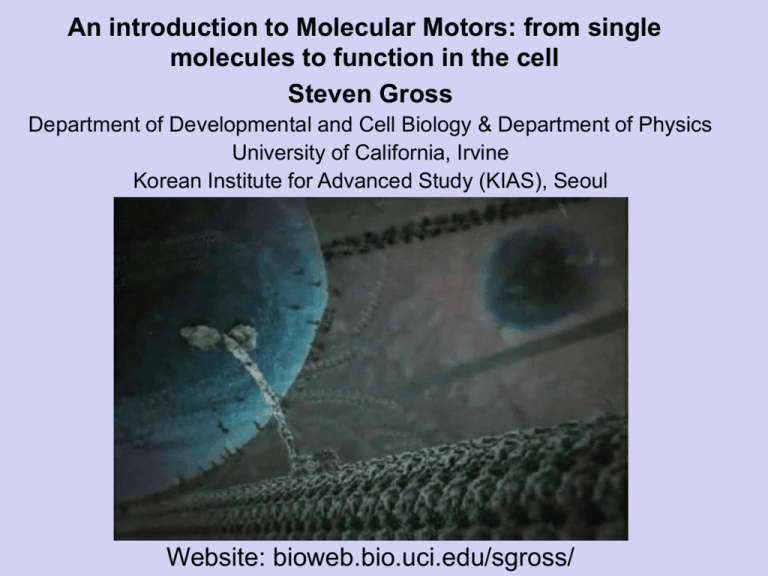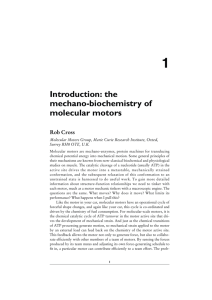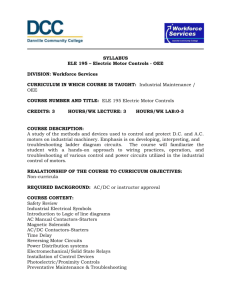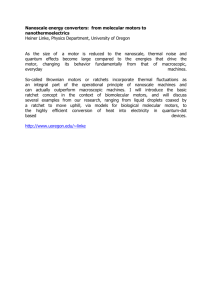
An introduction to Molecular Motors: from single
molecules to function in the cell
Steven Gross
Department of Developmental and Cell Biology & Department of Physics
University of California, Irvine
Korean Institute for Advanced Study (KIAS), Seoul
Website: bioweb.bio.uci.edu/sgross/
Cell Biology: a brief intro
tThanks to
Changbong &
the other organizers!
Cos-7 cells © Nikon MicroscopyU
D103 Cell Biology –SS1 2009 Lecture 1+2 © Grün - all rights reserved.
2
Introduction to Cell Biology
I.
II.
Introduction to cell biology
•
Why study cell biology?
…..biology can guide physics
•
What is the biology trying to achieve?
General principles
•
All cells are prokaryotic or eukaryotic
•
Investigating cells:
Cellular organization
Role of motors
Summer
School– lecture 1 © Gross - all rights reserved.3
D103 Cell Biology –SS1 2009 Lecture 1+2 © Grün - all rights
reserved.
Why Study Cell Biology ?
"There is a paradox in the growth of scientific knowledge. As
information accumulates in ever more intimidating quantities,
disconnected facts and impenetrable mysteries give way to
rational explanations, and simplicity emerges from chaos.”
Alberts, et al.
• Fascinating
• Provides insight into the mechanism of how cells work
We have to understand the details of a single cell in order to understand a
complex, multi-cellular organism.
• Essential for the understanding and the treatment of
human diseases.
Summer
School– lecture 1 © Gross - all rights reserved.4
D103 Cell Biology –SS1 2009 Lecture 1+2 © Grün - all rights
reserved.
All cells are
prokaryotic or
eukaryotic
Prokaryotic cell=Bacteria
• Simpler organization than Eukaryotic cell
• Some systems similar to eukaryotic cell
D103 Cell Biology –SS1 2009 Lecture 1+2 © Grün - all rights reserved.
lecture 1 © Gross - all rights reserved.5
Components and
Organization of the Cell
D103 Cell Biology –SS1 2009 Lecture 1+2 © Grün - all rights reserved.
Why motors?: The living cell is organized
Overview: Motors, and where
they are important
1.
2.
3.
4.
5.
Cytoskeleton, including AFs, MTs, and motors
Role of Cytoskeleton: Cargo transport
Cell Migration
Role of Cytoskeleton: Cell division
Communication of Cell with outside world:
endocytosis, exocytosis, control of receptors
6. Role of Cytoskeleton: Neuronal Cells
On MTs:
kinesin
dynein
On Actin:
myosin
General summary:
The road systems in the cell
Transport requires motors + roads!
• Microtubules stiff, arranged in a radial
fashion
• Actin random and everywhere
• MT Highway system
• Actin Local Roads
self-organization of cytoskeleton, especially
interactions with motors (allows feedback)
Regulation
Three families of molecular motors
Kinesin
Myosin-V
Dynein
Cargo
Cargo
KLC
Pi
KR1
Dynactin
binding
KR2
MR2
Ca2+
Pi
KAPP
KR3
MR1
Head
(ATPase)
Stalk
2 1 c
3
6
4 5
Lever (?)
KHC
Head (ATPase)
MT binding
Processivity: porters vs rowers
Processive (porter)
Non-processive
(rower)
Images: MCRI Molecular motors group
Kinesin is Processive; Myosin II
(muscle) is not. Why?
• A processive motor doesn’t let go of the substrate (MT or
AF) so the cargo doesn’t diffuse away
• Many processive motors could get in each others way--all
bound to the filament at the same time
• A non-processive motor lets go of the filament at some
point in its enzymatic cycle. Thus, multiple motors don’t
get in each others way--not active at exactly the same time
• Collective Velocity Different!
Cartoon: kinesin
Nucleotide hydrolysis conformational change AND
changes in MT affinity
Monte-Carlo simulation: single motor
Pstep, Pdetach2, and Poff are load dependent
Simulation reproduces known singlemolecule kinesin function
We’ll return to theory later to investigate multiple-motor transport
Homework: Simulate a motor walking (Very simple
Monte Carlo simulation)
Steps in simulation:
1. Check if bound (bound =true?)
2. If bound=true continue to 3, otherwise end ‘run’, determine how
many steps were taken by looking at counter.
3. Check if tries to step (probability check)
if tries to step either
a) falls off (decide which with
b) steps
probability check)
4. If steps increment step counter
5. If falls off set bound =false.
Each such set of steps simulates a single walking motor. Repeat many
times to get a distribution of ‘runs’
Homework, (hints):
Key point in simulation: size of timestep, and probability at each attempt.
Suppose that you know that kinesin takes 8 nm steps, and on
average goes 800 nm/sec. That means approx. 100 steps/sec.
Can you do a simulation, with time steps of 1/100th of a sec.?
(NO!!)
Suppose timestep = 1/10000 sec. What is the probability of
stepping in any given timestep?
Hint: if 1/10000 sec is the timestep(ts), then 10000 ts/sec, and
to get the correct average velocity, 100 of them should turn
into actual steps. (P)*10000=100 p = 100/10000=1/100, i.e.
at any single time step there is a 1 in 100 chance of stepping,
and a 99/100 chance of doing nothing.
Different Theoretical approaches to
understand motors
1. Monte-Carlo simulations, e.g based on the simple kinetic
approach I just showed (see e.g Kunwar et al, Curr. Biol.
18(16):1173-83 (2008).)
(can get from my website: bioweb.bio.uci.edu/sgross)
2. Masters Equations (see e.g Klumpp, Lipowsky, PNAS)
3. Will hear more from Dr. Joanny
Cargo transport
MT based dispersion of pigment
MT based aggregation of pigment
Cell Division:
an exciting example of
dynamic self-organization
Cell Replication: big picture
Why?
• Need addtl cells for development
• Need cells to maintain/repair body (+ adaptation).
Requirements for typical cell division:
• Increase cell size (except early embryogenesis).
• copy genome accurately.
• Segregate duplicated genome to each of daughter cell.
• Segregate organelles to each daughter cell.
Incorrect replication/regulation causes problems!!
• Insufficient division growth retardation, degeneration.
• Excessive division birth defects, cancer.
• Incorrect segregation of chromosomes similar effects.
Bio103-Fall
D103 – SS1
2009
lect 20-22
© Grün - all rights reserved
Bio
2009
© Steven
Gross
25
lecture 1 © Gross - all rights reserved.
Mitosis & Cytokinesis
Recommended Reading: MBOC 5e, pages 1069 - 1090
Bio D103 – SS1 2009 lect 20-22 © Grün - all rights reserved
26
lecture 1 © Gross - all rights reserved.
Mitosis & cytokinesis - what must the cell accomplish ?
No new protein synthesis after entry into mitosis
- better retain proteins required for life immediately after cytokinesis !
Condense chromosomes before trying to separate them
- think you can quickly separate many balls of unwound string ?
Disassemble nuclear envelope
- can you connect chromosomes to the centrosomes while the nuclear envelope is in between them ?
Ensure that sister chromatids can be reliably and quickly sorted one per daughter cell
- how do you assemble a dynamic scaffold that allows us to move chromosomes ?
Ensure that a set of chromosomes and adequate organelles are partitioned to each daughter cell
- better make sure that you divide the cell in the right place, and move things appropriately first !
Disassemble the scaffold, reform the nuclear envelope, allow chromatin to reorganize
- How to accomplish this without significant new protein synthesis ?
Bio
SS12009
2009
lectSteven
20-22 ©Gross
Grün - all rights reserved
lecture
BioD103
103-Fall
1© –Steven
Gross
©
27
Mitotic microtubules have a reduced half-life due primarily
to increased catastrophes
• In mitotic cells, rate of
elongation is about twice as fast
as that in interphase cells, but
shortening occurs at same rate.
• Although microtubules in
interphase cells undergo
catastrophe, they are able to
recover.
• In contrast, when microtubules
undergo catastrophe in mitotic
cells, the frequency of recovery
is greatly reduced.
• Catastrophes also MUCH more
common Mitosis
Figure illustrating recovery from catastrophe in interphase cells
Why are there more catastrophes?
Why don’t they recover?
Bio D1031©
– SS1
2009Gross
lect 20-22 © Grün - all rights reserved
lecture
Steven
28
Dynamic instability of microtubules is regulated by
multiple factors
• Local concentration of dimeric tubulin
available for incorporation into growing
microtubules.
• e.g. a microtubule binding protein, such
as stathmin, can reduce the local
concentration of free dimeric tubulin.
This would increase the likelihood of the
GTP cap becoming hydrolyzed and the
MT becoming unstable.
• Binding of microtubule associated
proteins (MAPs) to microtubules.
• Some MAPs can increase the stability of
the MT ends, while others (such as
kinesin-13, a catastrophin) can decrease
the stability.
Bio D103 – SS1 2009 lect 20-22 © Grün - all rights reserved
29
lecture 1 © Gross - all rights reserved.
Three microtubule-based structures are required
for mitosis
• Three distinct types of microtubule (MT) structures form during mitosis - astral, interpolar
and kinetochore MTs.
• Astral MTs - project from the poles and orient the spindle via interactions with the cell
cortex.
• Interpolar MTs - can be free at either end, can penetrate between and through
chromosomes, minus ends are close to centrosomes, overlap in zones of inter-digitation.
• Kinetochore MTs - plus ends are embedded in kinetochore, minus ends are at or near
spindle pole (aka centrosome), each human kinetochore captures around 20 independent
MTs.
Bio D103 – SS1 2009 lect 20-22 © Grün - all rights reserved
30
lecture 1 © Gross - all rights reserved.
Motor proteins govern spindle assembly and function
• Kinesins 4, and 10 (both + end directed) are chromokinesins that bind to
chromosomes and move chromosomes to + end of kinetochore MT.
• Kinesin 13 (not shown; at kinetochore) is a catastrophin that can mediate MT
shrinkage.
• Kinesin 5 (+ end motor) contains two motor domains that interact with anti-parallel
(inter-polar) MTs, and slide them apart (pink arrows).
• Kinesin 14 (- end motor) contains a single motor domain, but can cross-link MT
(i.e. one MT is cargo) and pull them together (blue arrow).
• Dynein / dynactin (- end motor) can bind the cell cortex as cargo, and pull astral
MT out from centrosome.
31
Bio D103 – SS1 2009 lect 20-22 © Grün - all rights reserved
lecture 1 © Gross - all rights reserved.
Neuronal cell function
Microtubule-Based Molecular Motors Enable Transport
(Harvard BioVisions)
Particle: 100nm
Distance: 1cm
Diffusion: ~ 7-8 Months
D ~ 0.5 x 10-7 cm2/s
Sattelle et al., Eur Biophys J. (1987)
Transport by motors: ~ 5 hrs
Transport in Axons: Remarkable and Crucial Task
New materials (eg. neurotransmitter)
Old materials, External survival factors
Cell Body
Central
Nervous
System
Axon Terminal
Muscle
Axon
Axon
~ 1m
www.alzheimer-net.ch
Herpes virus particles moving in an axon
2mm
Specific Challenges in Small-caliber neurons
Cell Body
Relatively easy to move
(viscosity < 10X water)
Axon Terminal
Harder to move (effective viscosity
larger due to no-slip bdry conditions,
and difficulty displacing obstacles)
2 recent papers:
Theory: J. Wortman et al, Biophys J. (2014)
Expt: BR Narayanareddy et al, “Mitochondrial Movement:
Differences Between Transport in Neuronal Cell Bodies Versus Processes” Traffic
(2014)
Challenges in understanding motor
function (mostly solved):
1) how do single molecules work?
2) how can we determine the function of
molecules too small to see by eye?
3) experimental ways to investigate function
of single molecules
Challenges in understanding
transport/motor function (not so solved):
1) Regulation: how is all of this controlled?
2) single-molecule ENSEMBLE
3) Properties of ensembles: how many
motors, where in cells, etc.
4) how do groups of proteins function
together?
5) Why choose a specific motor/motors for a
specific job—what makes a motor well
suited for a particular function?






